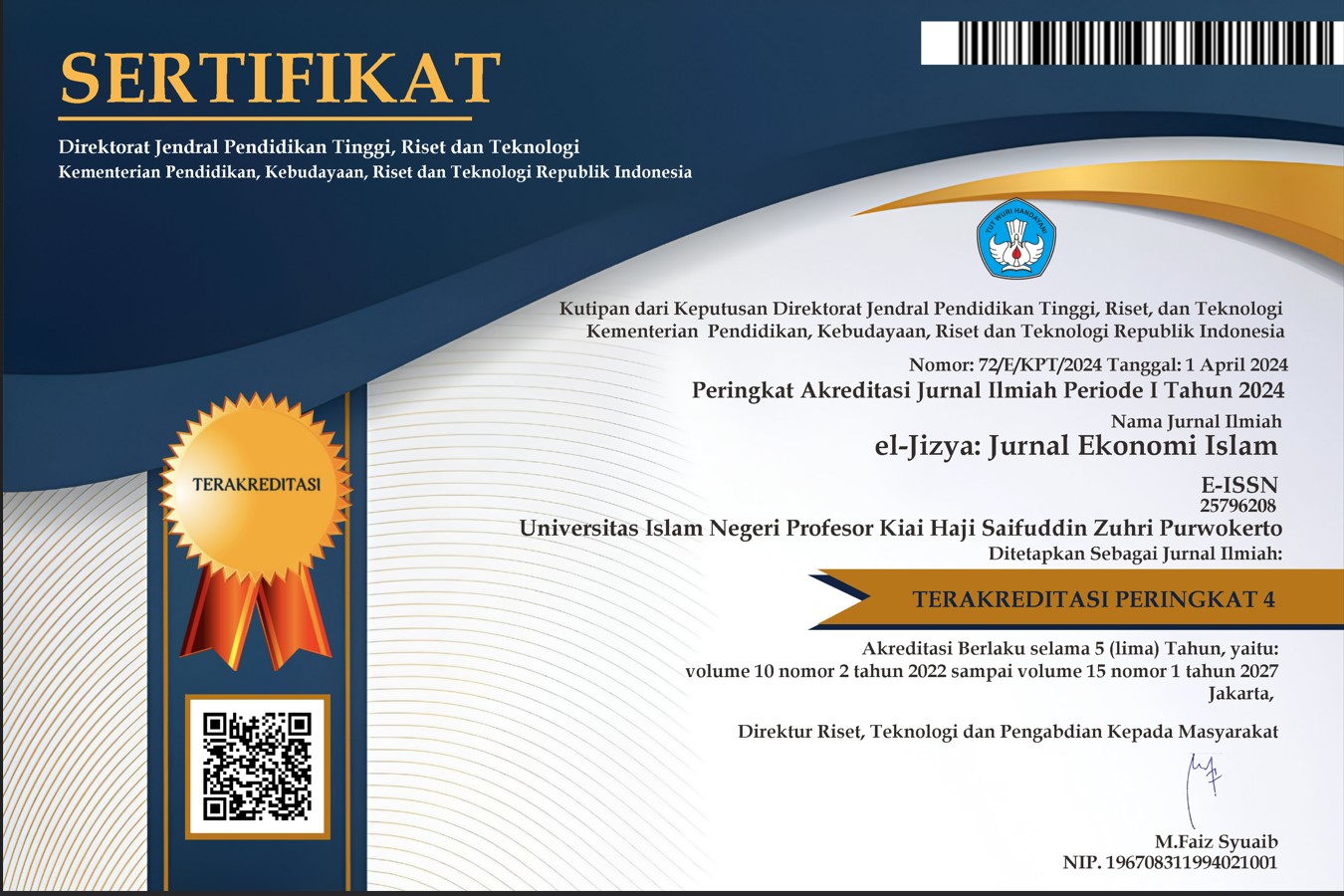M-DIN Application Strategy of Bank Muamalat KCP Kuningan in the Era of Bank Digitalization
DOI:
https://doi.org/10.24090/ej.v12i1.10551Keywords:
digitalization, M-DIN application, competitive strategy, user interestAbstract
In the era of digitalization, the banking sector undergoes significant transformation to meet the increasingly sophisticated and mobile demands of customers. Bank Muamalat, as a leading Islamic bank in Indonesia, is not exempt from the pressure to innovate and adapt to technological changes. This research employs a qualitative method with a case study approach at Bank Muamalat KCP Kuningan. Data is collected through interviews with internal bank informants and customers, as well as direct observations. The research findings indicate that the operational procedures of the M-DIN application at Bank Muamalat are proven to be simple and user-friendly, providing convenience from registration to the creation of Transaction Identification Numbers (TIN). The bank adopts a proactive strategy with innovative features, including aspects of Islamic principles and unique services, demonstrating awareness of technological innovation. Active education provided to customers by bank employees successfully increases user interest in M-DIN. The application is directed to every customer opening an account, resulting in a significant increase in M-DIN adoption by Bank Muamalat.References
Abdus, S. D. (2018). Financial Inclusion in Sharia Banking Based on Digital Banking: Optimization and Challenges. Al-Amwal: Journal of Sharia Economics and Banking.
Afdiana, F. (2022). Analysis of the Ability to Use Hajj Funds According to Law 34 of 2014 (Study from the Perspective of Maslahah Mursalah) (Doctoral dissertation, UIN Ar-Raniry).
Ahmed, D. (2021). Islamic Network Digital Financial Innovation ( DIN) Optimizing Banking Services In the Digital Era (Case Study of Bank Muamalat). Islamic Banking and Finance.
Ahmed, H. (2014). Islamic banking and Shari'ah compliance: a product development perspective. Journal of Islamic finance, 3(2).
Alam, N., Gupta, L., & Zameni, A. (2019). Fintech and Islamic finance. sl: Springer International Publishing.
Al-Filali, I. Y., Attia, A., Husseiny, A. A., & Alhamadi, A. (2019). Planning under uncertainty using chess principles, strategies and tactics. Middle East Journal of Management, 6(4)
Andriani, A. D., Yuniawati, R. I., Hamidin, D., Priambodo, A., Sulaeman, M., Susanti, L., & Martono, S. (2022). Indonesia's Transformation Towards a Cashless Society. Tohar Media.
Anggraini, E., & Risman, A. (2024). Comparison of the performance of conventional stock mutual funds with sharia stock mutual funds using the Sharpe Index, Treynor Index, and Alpha Jensen Index methods conducted during the Covid-19 pandemic period. Realible Accounting Journal, 3(2).
Aryanti, L. T. (2023). The Effect of the Use of the Muamalat Din Application on Interest with the Tam Method in Bank Muamalat Medan Customers. SAUJANA: Journal of Sharia Banking and Sharia Economics.
Azhari, I. M. (2022). Waiting List Problems in the Implementation of Hajj in Banda Aceh City (Doctoral dissertation, UIN Ar-Raniry).
Bank Muamalat, https://www.bankmuamalat.co.id/
Bianchi, R. R. (2013). Islamic globalization: Pilgrimage, capitalism, democracy, and diplomacy. world scientific.
Billah, M. M. S., Ghlamallah, E., & Alexakis, C. (2019). Encyclopedia of Islamic insurance, takaful and retakaful. Edward Elgar Publishing.
BPKH, https://ppid.bpkh.go.id/tugas-dan-fungsi/
Chikmah, A. (2023). The use of digital marketing to increase the millennial generation segment at Bank Muamalat Indonesia at KCU Kudus (Doctoral Dissertation, Sultan Agung Islamic University, Semarang).
Dirwan, D. (2022). Customer Decision to Use Mobile Banking from the Side Convenience, Benefits and Convenience. SEIKO: Journal of Management & Business.
Doraisamy, B., Shanmugam, A., & Raman, R. (2011). A Study On Consumers'perferences Of Islamic Banking Products And Services In Sungai Petani. Academic Research International, 1(3), 290.
Effendy, B. (2005). Islamic Economic Institutions in Indonesia: A Religio-Political Perspective. Islam in Southeast Asia: Political, social and strategic challenges for the 21st century, (11), 64.
Ekawati, D., Tohir, T., & Susanto, S. (2024). Optimization of Consumer Protection and Increase of Virtual Currency Trading in Indonesia: A Study on Financial Services Authority Regulation. Al-Ishlah: Jurnal Ilmiah Hukum, 27(1), 60-75.
Ervina, N., Warti, R., & Yanto , N. (2023)). Application of Muamalat Din Services in the Ease of Transactions at PT Bank Muamalat Indonesia KCP Serdang. El-Mujtama: Journal of Community Service.
Financial Services Authority, https://www.ojk.go.id/
Firdaus, R., Margiutomo, S. A. Dulame, I. M., Efitra, (2023). Digital Business Trends (Digitalization-Based Business Optimization & Optimization).
Hanafi, A. I. & Firdaus, M. A. (2023). Exploring the Impact of the Latest Technological Innovations in Sharia Investment. Journal of Religion, Social, and Culture.
Hania, I. F. (2022). The Influence of Experiential Marketing, Corporate Image and Service Quality on the Interest of Users of the Muamalat Din (Digital Islamic Network) Mobile Banking Application (Case Study on Bank Muamalat Kcp Kotabumi Customers) (Doctoral dissertation, UIN Raden Intan Lampung).
Haryono, D., Ghafur, A. H. S., & Somantri, G. R. (2023). The Challenges of Digital Banking in Today’s Banking Industry. Indonesian Interdisciplinary Journal of Sharia Economics (IIJSE).
Imran, M., Din, M. S. U., Rehman, M. A. U., & Kim, B. S. (2023). MIA-NDN: Microservice-Centric Interest Aggregation in Named Data Networking. Sensors, 23(3).
Iqbal, M., Molyneux, P., Iqbal, M., & Molyneux, P. (2005). History and growth of Islamic Banking and Finance. Thirty Years of Islamic Banking: History, Performance and Prospects
Isnaena, E., & Nurlaeli, I. (2024). Sharia Mutual Fund Transaction Practice in the DSN-MUI Fatwa Perspective Seed Application number: 20/DSN-MUI/IV/2001. el-Uqud: Journal of Sharia Economic Law Studies, 2(1)
Jaelani, A. (2016). Islamic tourism development in Cirebon: The study heritage tourism in Islamic economic perspective. Journal of Economics Bibliography, 3(2).
Jumah, B. (2019). Tourism planning challenges and prospects in a destination with political conflict: the case study of Nablus city, Palestine (Master's thesis, Eastern Mediterranean University (EMU)-Doğu Akdeniz Üniversitesi (DAÜ)).
Laldin, M. A., & Djafri, F. (2019). Islamic finance in the digital world: Opportunities and challenges (Kewangan Islam dalam Dunia Digital: Peluang dan Cabaran). Journal of Islam in Asia (E-ISSN 2289-8077), 16(3)
Long, D. E., & Long, D. (1979). The Hajj today: A survey of the contemporary pilgrimage to Makkah. SUNY Press.
Makbul, M. (2021). Data collection methods and research instruments.
Maysami, R. C., & Kwon, W. J. (1999). An Analysis of Islamic Takaful Insurance. Journal of Insurance Regulation, 18(1).
Mohamed, S. K., Suliman, A. E. T., Mazen, J. A. S., & Abu-Naser, S. S. (2020). Strategic Creativity in Islamic Banks in Palestine between Reality and Implementation.
Muscat, M. (2015). Banking on the divine: everyday Islamic banking practices in Malaysia (Doctoral dissertation, London School of Economics and Political Science).
Mutiasari, A. I. (2020). Development of the Banking Industry in the Digital Era. Journal of Business Economics and Entrepreneurship.
Naeem, M., & Ozuem, W. (2021). The role of social media in internet banking transition during COVID-19 pandemic: Using multiple methods and sources in qualitative research. Journal of Retailing and Consumer Services, 60
Nurfadilla. (2021). Opportunities and Challenges of Sharia Banks in Facing the Digital Banking Era (Study on Bank Muamalat Palopo City).
Osman, S., & Din, S. A. M. (2022). The rhapsody of mobile applications: A case study of Malaysian travellers. In Handbook of Technology Application in Tourism in Asia. Singapore: Springer Nature Singapore.
Othman, Y. H., Abd Latib, M. F., Ahmad, M. N., & Hasnan, R. (2020). The role of Islamic social finance in reviving the economy during COVID19 pandemic crisis. International Journal of Muamalat, 4(1), 147-152.
Panjaitan, U. (2023). Analysis of the impact of technological disruption on the fulfillment of human resources in Islamic banking in Indonesia (case study: PT. Bank Muamalat Indonesia KCU Padangsidimpuan) (Doctoral dissertation, UIN Syekh Ali Hasan Ahmad Addary Padangsidimpuan).
Raida, E. (2020). Conformity of the management of sharia pension funds at Bank Syariah Mandiri with MUI fatwa Number 88/DSN-MUI/XI/2013 (Study on PT Bank Syariah Mandiri Muara Teweh) (Doctoral dissertation, IAIN Palangka Raya).
Renita, N. (2014). Mechanism of Muamalat Protected Pension Savings at Bank Muamalat Indonesia Purbalingga Sub-Branch (Doctoral dissertation, IAIN Purwokerto).
Saputra, J., Kusairi, S., Sanusi, N. A., & Abdullah, Y. (2016). An analysis of determination for life insurance premiums: The concept and practice of Conventional and Islamic life insurance (Family Takaful). Malaysian Journal of Applied Sciences, 1(2)
Septiana, D., Haque, M. G., Simatupang, B. M., & Budhijana, B. (2024). Operational and Marketing Strategic For Integrated Digital Service Attractiveness: A Study on" Madina" From Bank Muamalat Indonesia. Journal Research of Social Science, Economics, and Management, 3(9).
Shaikh, A. A., & Karjaluoto, H. (2015). Mobile banking adoption: A literature review. Telematics and informatics, 32(1)
Sihotang, M. K., & Hasanah, H. (2021, February). Islamic banking strategy in facing the new normal era during the Covid 19. In Proceeding International Seminar Of Islamic Studies (Vol. 2, No. 1, pp. 479-485).
Skinner, C. (2014). Digital bank: Strategies to launch or become a digital bank. Marshall Cavendish International Asia Pte Ltd.
Supriadi, Y. N., MM, C., Mutiasari, A. I., SE, M., Ramadhaniyati, R., Novien R. (2023). Banking Management. Scholar Mulia Mandiri.
Surya, Y. A. & Asiyah, B. N. (2020). Comparative Analysis of the Financial Performance of Bank BNI Syariah and Bank Syariah Mandiri during the Covid-19 Pandemic. Iqtishadia Journal of Sharia Economics & Banking.
Ullah, S., Harwood, I. A., & Jamali, D. (2018). ‘Fatwa repositioning’: the hidden struggle for Shari’a compliance within Islamic financial institutions. Journal of Business Ethics, 149.
Wahyuningsih, N. & Janah, N. (2018). Factors Affecting Customer Satisfaction Using Internet Banking at Bank Muamalat. Al-Amwal: Journal of Sharia Economics and Banking.
Wang, M., Cho, S., & Denton, T. (2017). The impact of personalization and compatibility with past experience on e-banking usage. International Journal of Bank Marketing, 35(1)
Zahira, H. (2022). Optimizing the Use of Mobile Banking Service System in Attracting Customer Interest at Pt Bank Syariah Indonesia Bogor Cileungsi Metland Sub-Branch Office (Bachelor's thesis, Faculty of Da'wah and Communication Sciences, Syarif Hidayatullah State Islamic University, Jakarta).
Zakiruddin, M. A. (2023). Hajj and Bureaucracy in Indonesia. CV. Mitra Cendekia Media.
Downloads
Published
How to Cite
Issue
Section
License
Copyright (c) 2024 Abdul Ghoni, Tria Lestari, Toto Suharto, Alvien Septian Haerisma

This work is licensed under a Creative Commons Attribution-ShareAlike 4.0 International License.
Authors who publish with this journal agree to the following terms:
- Authors retain copyright and grant the journal right of first publication with the work simultaneously licensed under a Creative Commons Attribution-ShareAlike License that allows others to share the work with an acknowledgement of the work's authorship and initial publication in this journal.
- Authors are able to enter into separate, additional contractual arrangements for the non-exclusive distribution of the journal's published version of the work (e.g., post it to an institutional repository or publish it in a book), with an acknowledgement of its initial publication in this journal.
- Authors are permitted and encouraged to post their work online (e.g., in institutional repositories or on their website) prior to and during the submission process, as it can lead to productive exchanges, as well as earlier and greater citation of published work (See The Effect of Open Access).















